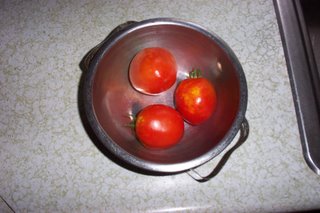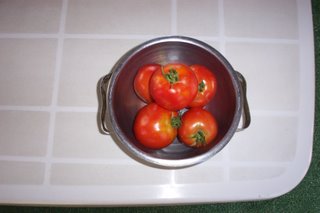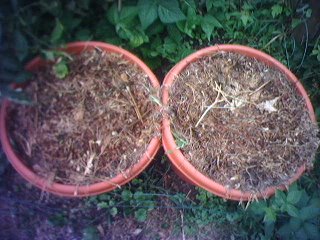

I've gathered yet more ripe tomatos from the Garden today. There seems to be a never-ending supply of them. However, I've also noticed small tomato bugs attacking the leaves of my plants. Clearly the tomatos have reached the peak of their productivity and a gradual weakening of vigour can be expected in the coming weeks. The String Bean plants are looking rather worn out right now, and this they should be. After delivering six batches of their wonderful beans, it won't be too many days before these plants return to the happy compost heap from which they came. Thus the old and dying are recycled into the new. Speaking of the compost bins, the earth worms have clearly done their work. After 3 weeks of composting the huge heap of vegetation has shrunk considerably. The two bins now contain a combined 160 lbs of decaying organic matter, enough to fertilize an area 5 times the current size of my garden next year.

I've noticed that food plants in their natural conditions face tremendous challenges just to survive. They need to extract every last bit of resources from the soil to support their growth. They are greatly affected by changing weather and availability of water. During youth, they are attacked by a host of pests and diseases, during old age, yet another plague of pests and parasites work to shorten their days. Yet the wonder of it all is that the produce of these unmodified heirloom plants taste so much better than any mass produced variety of the same type.
Could it be that the tomatos, beans, and potato plants that survives the ordeals of their natural environment to reproduce simply has better tasting offspring? This question can be conversely applied. 70% of all tomatos currently consumed in the U.S are Genetically modified. Almost all of these tomatos include the insertion of a certain gene from a deep sea eel. Why are there eel genes in tomatos one may inquire? Well, the eel gene prolongs the life and appearance of the tomato fruit by 8 fold. That is, a normal tomato that is allowed to ripen on the vine, will shrivel up and rot within 1 week, a genetically-modified tomato of this type will stay as fresh and beautiful looking as the day it was picked off the vine for 2 months. Yet there is one defect, they just don't taste very good and couldn't be made to taste any better after a decade of additional genetic tinkering. For some odd reason, gmed tomatos of this kind lost the intrinsic freshness and tartness that real ripe tomatos have during it's brief days of youth and beauty. But people simply bought what looked good and wholesome, and the eel-derived tomato is now on everyone's dinner table. Some food for thought...
No comments:
Post a Comment